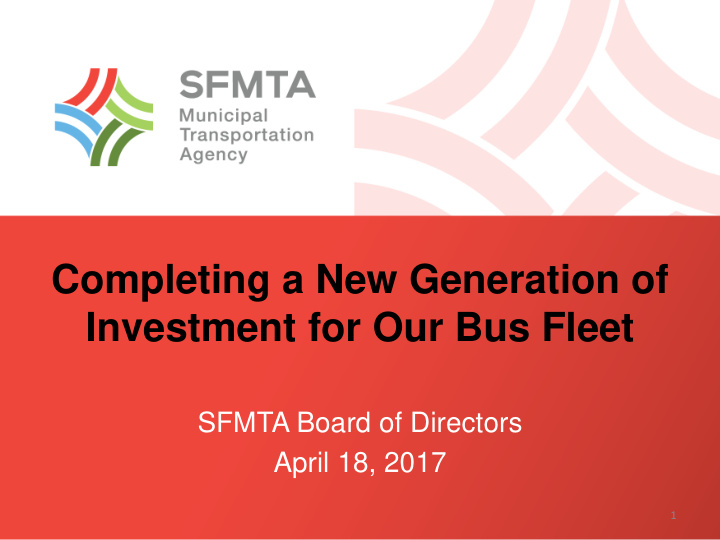



Completing a New Generation of Investment for Our Bus Fleet SFMTA Board of Directors April 18, 2017 1
Fleet Plan Overview • Since 2013, SFMTA has transitioned from an old and unreliable fleet to a state-of-the-art vehicle program • Current fleet replacement includes over 800 new vehicles, approximately 400 have arrived to date • Executing the 40ft Trolley option for 185 new buses is the last critical step and will replace SFMTA’s oldest vehicles 2
Fleet Plan Guiding Principles • Average Fleet Age: Establish a consistent average fleet age of 5-8 years. • Sustainability: Support the San Francisco Climate Action Plan and related City policies by continuing to invest in low and zero emission vehicles • Reliability: Continue to improve service and prioritize reliability when procuring vehicles, maintaining vehicles and designing enhancements • Performance-Based Procurements: Prioritize vehicle safety and reliability and encourage industry innovation and maintainability • Maintenance Standards: Continue robust maintenance standards and practices established in 2014 including maintaining or exceeding Original Equipment Manufacturer 3 (OEM) schedules
New Trolleys, More Hybrids, in 2017 4
814 New Buses Planned and/or Delivered • 2013-14: First 112 40ft Hybrids delivered • 2015-18: An additional 200 40ft and 224 60ft Hybrids are underway • 2015-2018: 60 60ft Trolleys arrive in 2016, 33 more planned by Spring 2018 • 2017-2019: 185 40ft Trolleys proposed Trolley Contract Phase 40ft Trolley 60ft Trolley Contract Status Base 0 60 Exercised 2016 (Contract Mod #1) 0 33 Exercised 2017 (Contract Mod #2) 185 0 Proposed Trolley Total 185 93 5
Worst Performers Drag System Down • At up to 17 years old, they are oldest in the system, well past useful life of 15 years • Vehicles suffer from poor reliability - Trolley coaches account for over 40% of equipment related delays • Parts hard to find since manufacturer out of business 6
Trolley Coaches Make Sense for SF Topography – Trolley coaches can operate more easily on hills than motor coaches Smoother & Quieter ride - Does not produce diesel engine noise that can disturb the neighborhood No Air Pollution – Trolleys contribute zero green house gases to the community No Need for Fuel – No diesel and the electricity to power the trolleys is very low cost Infrastructure Already Exists - Use existing overhead wiring throughout City 7
Trolley Network • Approximately 200,000 trolley boardings a day • Trolley customers make up 30% of total ridership • 15 routes in the Trolley Network • Includes some of the highest ridership in the system (e.g., 1 California, 14 Mission, 30 Stockton) 8
Community & Operator Feedback Informed Design Bus design incorporates extensive input from Operators, people with disabilities and the general riding public Key features include: • Ergonomic Operator compartment • Air conditioned climate control for passenger comfort • Easily accessible with low floor design which requires no additional steps at the doors • Generous amount of priority seating identified with international symbols • More passenger capacity with perimeter seating • Flip up seat to accommodate baby stroller • More hand straps and yellow stanchions throughout for easy visibility 9
Operational Benefits • Delivers enhanced reliability within our current operating and infrastructure environment • Purchasing from New Flyer, who has more than 40 years experience building trolleys coaches • State of the art battery system allows extended travel without overhead power if needed to support service disruptions, special events and Citywide construction • Common parts with hybrids helps streamline maintenance 10
Environmental Benefits Meets Climate Action Plan goals: • Green Energy: Minimum fuel costs • Power generated by Hetch Hetchy water reservoir, owned by the city, minimal costs • ZERO Emissions: Definitely will not contribute to global warming 11
Potentially the Last Trolley Procurement Battery industry has come a long way, but is not yet ready for San Francisco • 40ft Trolley routes are our hilliest and most crowded (e.g., 1 California, 30 Stockton) • Battery range not able to support 24 hour service on routes such as the 22 Fillmore and 24 Divisadero Significant cost, time and uncertainties associated with support infrastructure • Current fleet cannot last any longer – customers are already experiencing major breakdowns and only expected to get worse 12
Cost and Delivery Schedule Schedule: • First two buses arrive by the end of 2017!!! • Production completed by Fall 2019 Cost: • Cost per bus ~ $1.2M • Total cost ~ $265M 13
Recommend
More recommend